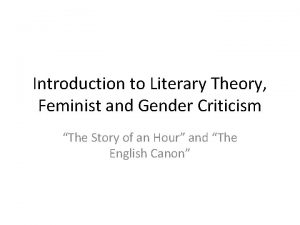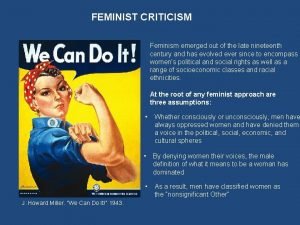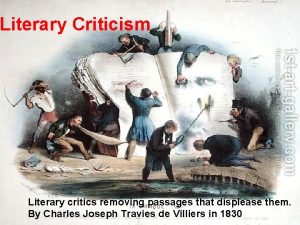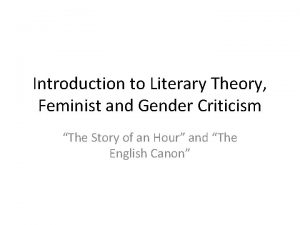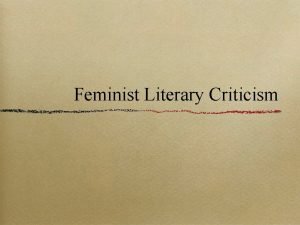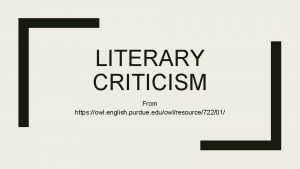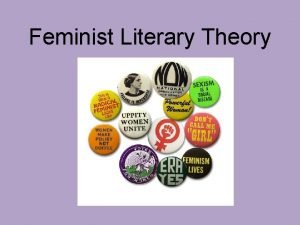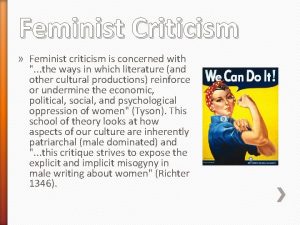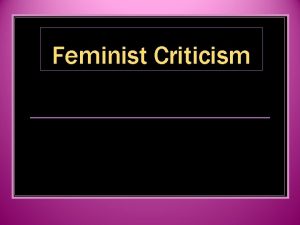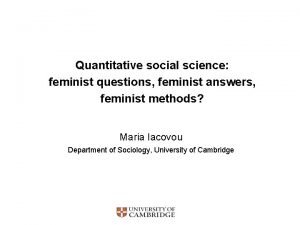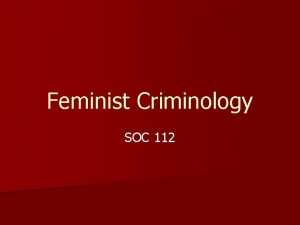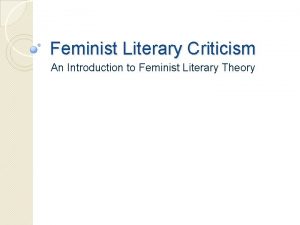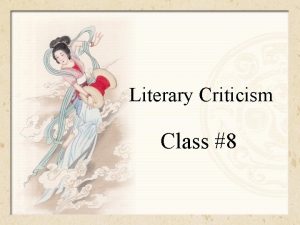Feminist Criticism Feminist criticism is especially concerned with








- Slides: 8

Feminist Criticism “Feminist criticism is especially concerned with the way gender assumptions, especially about women, operate in the reading and writing of literary texts. Feminist critics wish to show literary texts either sustain or challenge the structure of patriarchy – a social system in which power is kept in the hands of men.

Feminist critics argue that gender inequalities are reproduced at three levels: – – – in the production of texts in the structure and language of texts and through reading practices. ” Literary Terms, A Practical Glossary

First Wave of Feminism l Late 1700 s – early 1900 s l Writers, thinkers and activists are concerned with the issue of equality, highlighting “inequality between the sexes” l suffrage movement/enfranchisement

“A Room of One’s Own” l Virginia Woolf imagines that Shakespeare had an equally talented, creative sister, “Judith” l Woolf undertakes an imaginative exercise to depict the inequities of the Elizabethan era l l Class Education Creative expression Suppression of individuality

Second Wave l Exposes the arbitrariness of male privilege and reverses it l Advocates matriarchal values

Third Wave Feminism (or Post-Feminism) l l A dismantling of the binary of male and female Without the oppositional structure of male v. Female. . . oppression, bias, suppression should not happen There are no absolutes: “male” and “female” cannot be defined or qualified gender is a construct

The Male Gaze Laura Mulvey, “Visual Pleasure and Narrative Cinema, ” 1975 Mulvey coined the phrase “the male gaze” in relation to how women are typically the objects, rather than the possessors, of gaze in the film medium. The control of the camera (and thus the gaze) comes from factors such as the assumption of heterosexual men as the default target audience for most films. Similarly, camera operators, directors, producers are more commonly men then women.

Key Questions l Key Questions: – – – When women appear as characters, how important are they? How individual in their own right? Are they credited with their own existence and character? In their relationship with men, how are they treated? How is the relationship between men and women portrayed? What are the power relationships which exist between men and women? How are male and female roles defined? Are they related to domesticity? Do characters take on traits from opposite genders? How so? How does this change others’ reactions to them? What does the work reveal about the operations (economically, socially, politically, psychologically) of patriarchy? Are women given equal status? Ignored? Patronized? Demeaned? Pedalstalized? Is there evidence of competition by women to secure the attention of men in the text? How much concern do the male characters exhibit about women’s concerns? l l l Sources: Literature: An Introduction to OWL: Purdue Online Writing Lab: http: //owl. english. purdue. edu/owl/resource/722/01/

